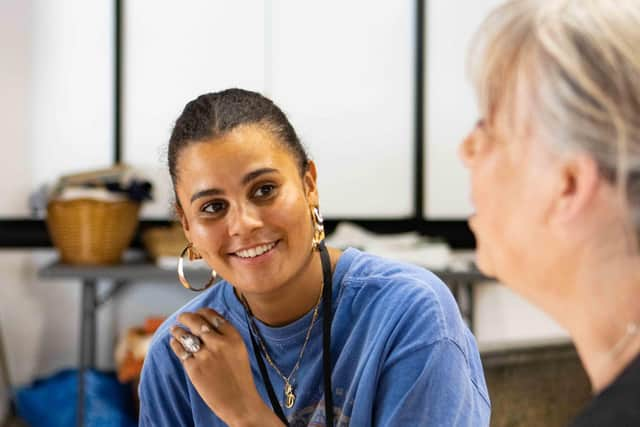The Steamie at Dundee Rep: 'It's become embedded in the culture'


Is there another show like it? The Steamie is a play so beloved by audiences that they don't just recognise the songs – those bittersweet ballads written by David Anderson – they also greet the big speeches like old friends. The one in which the aging Mrs Culfeathers expounds her theory about Galloway's mince arrives like a familiar aria, with half the audience mouthing along.
"I've had people quote whole chunks of songs and text to me when I've told them I'm doing it," says Edinburgh's Becky Hope-Palmer who is directing the play at Dundee Rep with the resident ensemble. "If one of the actors goes down, we'll have a queue round the block."
Advertisement
Hide AdIn the 35 years since its debut, Tony Roper's affectionate comedy about a group of women in a 1950s Glasgow washhouse has enjoyed so many revivals on stage and turned into such a staple of the Hogmanay TV schedules that it has become embedded in the culture.
If you are among Scotland's younger generation of theatre directors, you almost certainly studied it at school, answering questions about it before you even saw it. That is the case for Hope-Palmer. "Every drama class has studied it for years," she says. "So you've got all that in your head about, 'These are the women,' and ‘These are the themes,' and so on. But I love to think of it as if it's a new piece. Hopefully, there is room for us to bring our flavour to it without disrupting any of the rhythms."
When it comes to honing the right skills for The Steamie, Hope-Palmer has learned from the best. After training at the Royal Conservatoire of Scotland, she spent time as a resident assistant director at Edinburgh's Royal Lyceum. At that theatre, she assisted Lu Kemp on her excellent production of Sue Glover's Bondagers, another female-led ensemble piece about women at work.
Where Glover's play was about indentured farm hands toiling on the land before the arrival of mechanisation, The Steamie is set in that pre-laundrette era when washing clothes was backbreaking work. It captures both the drudgery and camaraderie of the women's lives. For the director, that means getting the fine details right.
"They have moments when they are distracted and come away from their work, but for the most part, these women had an hour to get everything done," she says. "We have to make sure they're doing that. One of the actors said she was sweating just from pretending to do it – and it's not even hot and steamy like it would be. It gives you an idea of how physically fit even the oldest of the women were if they had to do that every week."


So central is work to the play that Hope-Palmer decided nothing could happen in rehearsals until they had figured out what each woman was physically doing. "They've all got their own process," she says. "Mrs Culfeathers has so much to do as the one that is being paid to wash other people's clothes, so Irene Macdougall, who plays her, has a whole other system from everyone else. She's worked it out in her head to the finest detail."
Advertisement
Hide AdThe appeal of the play, first seen in 1987, lies in its paradoxical pull in two directions. On the one hand, it presents a nostalgic view of good neighbours gearing up for a New Year celebration. We see these women at their most unguarded, chatting unselfconsciously among friends, as if they could be people we know in our own lives. They are part of a close-knit society we would all like to be part of, especially in today's age of atomisation.
"The one benefit these women had was they knew every week they would be there," says Hope-Palmer. "They had to be for washing. They'd be there, they'd talk, they'd moan about whatever they needed to get off their chests. Now we have to arrange that in our busy lives. So you do watch it with a nostalgia and there's a great sadness around the play because you know it's not forever."
Advertisement
Hide AdOn the other hand, the play pulls no punches in its portrayal of the work, the demands of running a home and the reality of poverty. This is an era when a house on a new estate in Drumchapel seems like an impossible dream. So too does the concept of a washing machine. You cannot be nostalgic about a life of such drudgery.


"We know it for being brilliantly funny, but Tony is very clever in that he threads in poverty, loneliness and sadness," she says. "It's not subtext; they're open about it."
In this way, The Steamie both eulogises the inner-city communities of the post-war era and looks unromantically at the depravations of slum living. It warms us with its streak of sentimentality even as it chills us with the hardships.
"For me, it's a great programming by artistic director Andrew Panton, post-pandemic, because of what it says about community, the role of women in the household and about supporting each other," she says. "We all realised how much that means to us at a time of communal shift. These women were having to deal with the fall-out of the war and we're all struggling at the moment to pay bills and to ensure people are still being cared for. There are comparisons in that."
The Steamie is at Dundee Rep from 13 August until 10 September, www.dundeerep.co.uk